![]()
![]()
![]()
Use LEFT and RIGHT arrow keys to navigate between flashcards;
Use UP and DOWN arrow keys to flip the card;
H to show hint;
A reads text to speech;
89 Cards in this Set
- Front
- Back
|
Length scales ________ Area scales _________ |
Linearly, quadratically |
|
|
How big is a typical cell in diameter? |
10-100 microns |
|
|
How do you measure the mass of a cell? |
Measure changes in the resonant frequency of a cantilever very precisely. Small changes in Mass change for resonant frequency. |
|
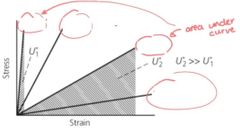
|
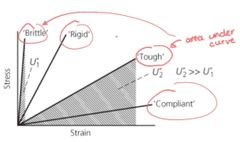
|
|
|
What is the formula for measuring the mass of a cell? |

|
|
|
Organelle responsible for protein synthesis, folding, modifications |
ER and Golgi apparatus |
|
|
What are the three types of cytoskeleton "scaffold"? |
Actin, tubulin, keratin |
|
|
What is the Young's modulus of a typical cell? What is the typical cell? |
1 kPa, fibroblast |
|
|
Describe the parallel plate technique that is used to measure Young's modulus. |

Squishes the Cell between plates, early method, customize equipment, difficult experiment |
|
|
Describe the atomic Force microscopy method used to measure Young's modulus. |
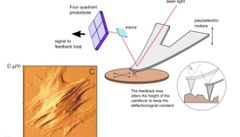
Force range: 0.01 nN- 100nN Length: single cells, proteins Type of sample: adherent cells (stuck to substrate) doesn't work for cells floating around Throughput: relatively low, 1 cell/minute |
|
|
Describe the micropipette aspiration method of calculating Young's modulus. |

Use pressure of pipette to measure E Force range: 0.01nN - 1000nN Length scale: single cells Typle of sample: cells in suspension (floating around) Throughput: low, 1 cell /minute |
|
|
Describe the optical tweezers method to calculate Young's modulus. |
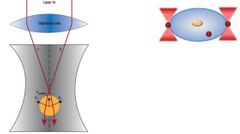
Force range: 0 - 200pN Length scale: subcellular -> membrane tethers, proteins (plasma membrane) Type of sample: proteins Throughput: low, more tedious |
|
|
Describe the method of optical stretcher to calculate Young's modulus. |

Force range: 0-200 pN Length scale: single cell Type of sample: suspension cells Throughput: high, 100s of cells/minute |
|
|
Which method to use to measure Young's modulus for Sickle cell anemia? (cells are in suspension) |
Optical stretcher (cells in suspension & high throughput) |
|

Describe Actin. |
~ important in muscle ~ helical structure ~ form structures, cell shape ~ forms actin filaments |
|

Describe Tubulin. |
~ separate nuclear material ~ cell division ~ form microtubules |
|

Describe keratin. |
~ cell mechanics ~ form intermediate filaments |
|
|
Length over which a slender polymer can be considered flexible |
Persistence length Lp = 100 L -> really flexible Lp = L -> semi-flex Lp = L/100 -> rigid |
|
|
Persistence lengths of actin filaments, microtubules, intermediate filaments |
Actin ~ Lp=15-20 um (fairly stiff) Microtubules ~ Lp=6mm (stiff) Intermediate filaments ~ Lp=1 um (softer) |
|
|
I want to measure membrane tension in adherent stem cells and compare with the expression of different proteins? (Young's modulus technique) |
Optical tweezer or AFM |
|
|
I want to measure the mechanical properties of podocytes adhered to a surface and compare between drug treatments? |
AFM (adherent cells) |
|
|
What is the power law? |
strain = at^B B=0 ~ elastic B=1 ~ purely viscous B~0.2 -> cell |
|
|
A motor protein that binds ro microtubules |
kinesin |
|
|
A motor protein that binds to actin filaments |
myosin |
|
|
Name 3 examples of mechanisms of how cells respond to their mechanical environment |
- protein unfolding - ion channel opening - protein expression |
|
|
How do cells sense and respond to mechanical forces in their environment? |
- transcription factor - recruited to the nucleus with changes in mech. environ |
|
|
What gives rise to the range of mech characteristics? |
- extracellular matric (ECM) ~polymeric proteins -> diff mech characteristics & modifications - multicellularity |
|
|
What are the 4 tissues? |
Epithelial ~ skin, linings Connective ~ tendons, bone, cartliage, blood Nervous ~ Brain, spinal cord, nerves Muscular ~ muscles, heart, smooth muscle |
|
|
What are the 3 types of collagen? |
Type 1 ~ bone, skin Type 2 ~ cartilage Type 3 ~ skin, blood vessels |
|
|
Sketch & describe how collagen fibrils are arranged. |

Staggered arrangement |
|
|
Describe GAG (connective tissue). |
hydrophilic, stiff, turgor, resist deformation |
|
|
Describe Hyaluronan (connective tissue) |
Simplest GAG, sustains compressive load, space filling, joint lubricant |
|
|
Describbe Proteoglycans |
GAGs attached to proteins, cartilage |
|
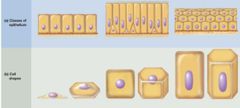
|
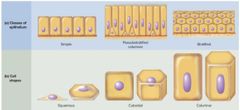
|
|
|
What are the 4 key intercellular adhesions? |
~ tight junctions ~ adherens junctions ~ desmosomes ~ gap junctions |
|
|
What do intercellular junctions (adhesions) do? |
Interface the cytoskeleton from neighbouring cells together |
|
|
Manner/style of moving |
gait |
|
|
A cycle of locomotor movements |
stride |
|
|
The formula for the force acting on each limb at rest |
BW/n ~ n is the number of limbs |
|
|
3 points of maneuverability |
~make tighter turns ~toppling condition (BW less than Gml x tan theta) ~slip condition (friction needs to be greater than Gml force) |
|
|
What are the 5 functions of muscles (smosh)? |
1) movement 2) stability 3) openings & passages 4) heat 5) store glucose |
|
|
Describe function, nuclei #, striations, & control of skeletal muscle. |
movement control multi nuclei striations yes voluntary control |
|
|
Describe function, nuclei, striations, and control of cardiac muscle. |
beating of heart 1 nuclei some striations involuntary control |
|
|
Describe the function, # nuclei, striations, and control of smooth muscle |
lining of tubes in body single nuclei No striations involuntary control |
|
|
Why is myosin important? |
~ converts chem energy into mech work ~ ATP to ADP facilitates ~ like an enzyme |
|
|
What composes thick filaments and thin filaments? |
~ thick = myosin ~ thin = actin |
|
|
What is the elasin filament composed of? |
titin |
|
|
In the muscle fiber/cell where is calcium stored? |
Sarcoplasmic recticulum |
|
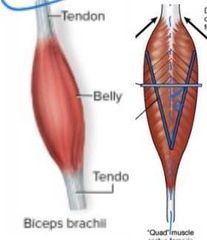
What are the two types of ways the fascicles are aligned along muscle length? |
Fusiform & pennate |
|
|
Sarcomeres in series = ____________ shortening Sarcomeres in parallel (pennate) = ___________ shortening |
more less (more force) |
|
|
Describe what happens during action potential. |
- K+ goes out - Na+ comes in - Changes electrical potential across the membrane - Ca in sarcomere releases locks on actin -> myosin can bind |
|
|
What are 5 things that affect the strenth of a twitch (fltth)? |
- twitch frequency - length of muscle - temp - fatigue (lactic acid, ATP amount) - hydration |
|
|
____________ means it can generate a force with a change in length ____________ means it can generate a force without changing in length |
Isotonic Isometric |
|
|
The general steps of muscle activation. |
~ activation from nerves ~ cascade o signalling ~ ACH -> neurotransmitter ~ action potential |
|
|
The contractile or active element -> A spring or elastic component -> A seconf elastic elemetn -> |
actin and myosin connective tissue movement of fluid |
|
|
What are the sources of ATP? |
1) creatine phosphate 2) oxidative phosphorylation 3) anerobically |
|
|
Muscle fatigue and endurance points |
~ potassium accumulation -> builds up and affects action potential ~ ADP accumulation ~ fuel depletion -> no ATP, start to use muscle ~ electrolyte loss -> need ions ~ central fatigue -> physchological |
|
|
What are 4 factors affecting muscle strength? |
~ muscle size ~ muscle fiber arrangement (pennate = more force) ~ size of motor units ~ aerobic exercise -> availability of oxygen |
|
|
What are the 2 factors affecting muscle healing? |
~ slower when immobilized ~ slow oxidative artophy more readily |
|
|
What 2 factors contribute to lung mechanics? |
1) naturally elastic~ amount of elastin & collagen, stiffer when inflated 2) Surface tension ~ expanding the lung, increases the size of interface between liquid + air -> costs energy |
|
|
What are the 3 types of skeletons? |
1) vertebrate 2) invertebrate 3) hydrostatic (worm, spider) |
|
|
What are the 5 functions of bone? |
1) support 2) protection 3) hematopoesis -> blood 4) framework for motion 5) mineral storage |
|
|
Collagen is not good at sustaining _______________ loads, it is better in ____________. |
Compressive, tension |
|
|
What are 2 types of bone defined by microstructure? |
lamellar bone -> layers of material ~compact/cortical ~spongy/trabecular woven bone -> random ~healing bone |
|
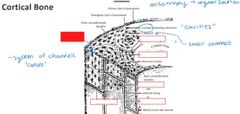
|
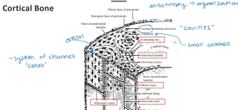
|
|
|
What are the characteristics of woven bone? |
~random oriented collagen fibers ~immature ~mineralizes quick ~synthesized where there is no bone ~reduced mech properties |
|
|
What are the mechanical property considerations of bone? |
~ not a uniform material -> density & more vary (aniosotropic material) ~ loading direction ~ Stronger is longitudinal & compression |
|

|
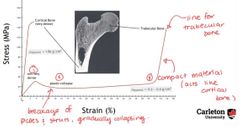
|
|
|
What are the characteristics of trabecular bone? |
~plates and struts surrounded by fluid ~viscoelastic properties ~ rate dependence with loading |
|
|
Sketch a force-extension response for muscle (active, passive, and a combination curves) |
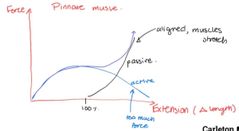
|
|
|
Under which loading is bone stronger, where does failure occur? |
stronger is compression then tension failure along max tensile stress |
|
|
What are the 3 types of bone cells? |
1) Osteocytes (mature, signalling &maintenance) 2) Osteoblasts (bone form) 3)Osteoclasts (resorbing) |
|
|
What is Wolff's Law? |
The remodelling of bone is influenced and modulated by mech stress |
|
|
Osteoblast characteristics |
~ don't divide ~ stress & failure = osteogenic cell production ~ osteogensis = formation of bone |
|
|
Osteoclasts characteristics |
~osteolysis =bone resorption ~stem cell derived ~multiple nuclei (cell fusion) ~ruffled border = increase SA |
|
|
How do cells sense and respond to mechanical forces in their environment? |
1) protein unfolding 2) tension sensitive ion channels 3) can impact gene expression |
|
|
What will maneuverability increase with? |
slower speed, increase adhesion, bigger feet relative to body size |
|
|
What are the 2 types of ossification? |
1) Endochondral - through cartilage 2) Intramembranous - direct deposition, surface |
|
|
What are the steps for tissue healing? |
1) inflammation 2) reorganization & regeneration 3) fibrosis replacement with connective tissue |
|
|
What are the connective tissue cell types (3)? |
~ fibroblast -> collagen secretion, immature ~ fibrocyte -> maintenance of connective tissue, mature ~ immune cells -> neutrophils, mast cells, plasma |
|
|
Characteristics of articular cartilage |
~ support & shock absorption ~ limited blood supply ~ virtually no nerves or lymphatic system ~ maintained by chondrocytes |
|

|

|
|
|
What is the function of tendons? |
- attach muscle to bone - transmit tension - mech advantage |
|
|
What is the function of ligaments? |
- attach articulating bone - guide joint motion - stability |
|
|
Sketch and describe how microfibrils are arranged |

Staggered |
|
|
Sketch the full tension-velcoity relationship for muscle |
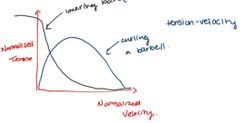
|
|
|
What is the function of Proteoglycan? |
- surface negative charge repep each other - attract water molecules - works to expand the molecule - collagen bears load in tension - prestress |
|
|
_____________ -> step change in stress _____________ -> step change in strain |
Creep, Stress relaxation |
|
|
What are the forms of lubrication in synovial joints? |
Fluid-film ~ hydrodynamic & squeeze film Boundary lubrication ~ glycoprotein |

